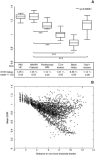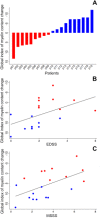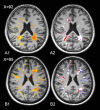Dynamic Imaging of Individual Remyelination Profiles in Multiple Sclerosis
- PMID: 26891452
- PMCID: PMC5006855
- DOI: 10.1002/ana.24620
Dynamic Imaging of Individual Remyelination Profiles in Multiple Sclerosis
Abstract
Background: Quantitative in vivo imaging of myelin loss and repair in patients with multiple sclerosis (MS) is essential to understand the pathogenesis of the disease and to evaluate promyelinating therapies. Selectively binding myelin in the central nervous system white matter, Pittsburgh compound B ([11 C]PiB) can be used as a positron emission tomography (PET) tracer to explore myelin dynamics in MS.
Methods: Patients with active relapsing-remitting MS (n = 20) and healthy controls (n = 8) were included in a longitudinal trial combining PET with [11 C]PiB and magnetic resonance imaging. Voxel-wise maps of [11 C]PiB distribution volume ratio, reflecting myelin content, were derived. Three dynamic indices were calculated for each patient: the global index of myelin content change; the index of demyelination; and the index of remyelination.
Results: At baseline, there was a progressive reduction in [11 C]PiB binding from the normal-appearing white matter to MS lesions, reflecting a decline in myelin content. White matter lesions were characterized by a centripetal decrease in the tracer binding at the voxel level. During follow-up, high between-patient variability was found for all indices of myelin content change. Dynamic remyelination was inversely correlated with clinical disability (p = 0.006 and beta-coefficient = -0.67 with the Expanded Disability Status Scale; p = 0.003 and beta-coefficient = -0.68 with the MS Severity Scale), whereas no significant clinical correlation was found for the demyelination index.
Interpretation: [11 C]PiB PET allows quantification of myelin dynamics in MS and enables stratification of patients depending on their individual remyelination potential, which significantly correlates with clinical disability. This technique should be considered to assess novel promyelinating drugs. Ann Neurol 2016;79:726-738.
© 2016 The Authors. Annals of Neurology published by Wiley Periodicals, Inc. on behalf of American Neurological Association.
Figures





Comment in
-
Pittsburgh compound B and other amyloid positron emission tomography tracers for the study of white matter and multiple sclerosis.Ann Neurol. 2016 Jul;80(1):166. doi: 10.1002/ana.24666. Epub 2016 May 9. Ann Neurol. 2016. PMID: 27098362 No abstract available.
-
Benzothiazole and stilbene derivatives as promising positron emission tomography myelin radiotracers for multiple sclerosis.Ann Neurol. 2016 Jul;80(1):166-7. doi: 10.1002/ana.24667. Epub 2016 May 9. Ann Neurol. 2016. PMID: 27098444 No abstract available.
References
-
- Ramagopalan SV, Dobson R, Meier UC, Giovannoni G. Multiple sclerosis: risk factors, prodromes, and potential causal pathways. Lancet Neurol 2010;9:727–739. - PubMed
-
- Kieseier BC, Wiendl H. Multiple sclerosis: advances, excitements, disenchantments. Lancet Neurol 2006;5:2–3. - PubMed
-
- Crawford AH, Chambers C, Franklin RJ. Remyelination: the true regeneration of the central nervous system. J Comp Pathol 2013;149:242–254. - PubMed
-
- Franklin RJ, Gallo V. The translational biology of remyelination: past, present, and future. Glia 2014;62:1905–1915. - PubMed
-
- Filippi M, Rocca MA, Barkhof F, et al. Association between pathological and MRI findings in multiple sclerosis. Lancet Neurol 2012;11:349–360. - PubMed
Grants and funding
LinkOut - more resources
Full Text Sources
Other Literature Sources
Medical

